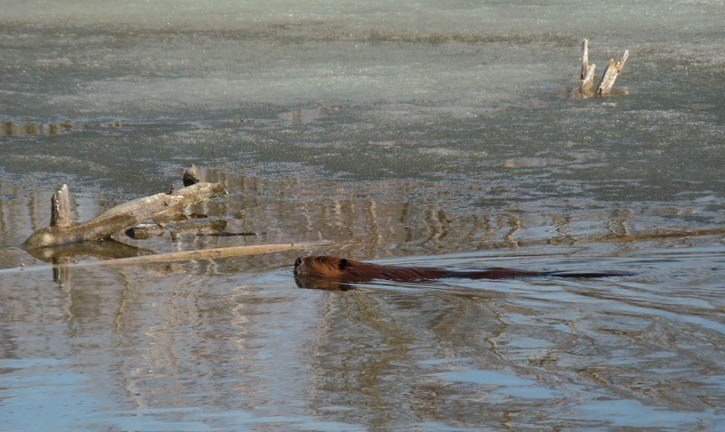Glynnis Hood is so passionate about beavers she has built a life around fighting for the enduring symbol of Canada.
In fact, when a Canadian senator called for a national emblem makeover in 2011 by replacing the buck-toothed tenacious creature with the majestic polar bear, Hood fought the move all the way.
Senator Nicole Eaton had called the beaver – which had the highest honour bestowed on a rodent when named Canada’s national emblem on March 24, 1975 – a “dentally defective rat,” and “toothy tyrant.”
“Whether you love them or not, the Canadian landscape was formed by the beaver,” said Hood, an associate professor at the University of Alberta’s environmental science and studies Augustana campus, at a recent meeting of the Bow Valley Naturalists.
“To say they are cute is an understatement, they are really cute. I know they’re annoying to people, but they have an ecological purpose. They are one of the most successful at changing the ecological landscape for the better.”
Beavers have long been considered pests for their unprecedented feats of ecological engineering – building dams, ponds and wetlands that can flood and damage human infrastructure – and persecuted by humans as a result.
They were almost completely killed for their pelts in the late 1600s and early 1700s when the fashion of the day demanded fur top hats. During the peak of the fur trade, well over 100,000 pelts were being shipped to Europe each year.
By the mid 19th century, the Canadian beaver was in danger of being wiped out, but then Europeans took a greater liking to silk top hats and the demand for beaver pelts all but disappeared and eventually populations began to recover, though never to historical numbers.
“This was their El Dorado, this was their oil sands … people made millions, all in the name of a hat,” said Hood.
“Beavers are one of the few species brought back from the brink of extinction. Almost every waterway that can support beavers – where we tolerate them – has beavers in them.”
Beavers are North America’s largest rodent and they are built for life in the water.
The most remarkable characteristic is the beaver’s tail, which is flat and has scales. They use it as a prop while cutting down trees, a rudder while swimming, a fat reserve in winter, a cooling device, and even an alarm when warning others in the colony of imminent danger.
The beaver’s eyes are equipped with a membrane, or third eyelid, to protect them underwater, which Hood refers to as “almost like swim goggles.” Beaver nostrils and ears are also adapted for life underwater, closing automatically when they dive.
“Really, they are the most incredibly designed creatures,” said Hood. “They are amazingly well adapted to their environment.”
Hood spent 19 years with Parks Canada and five years in other protected areas, but a big part of her career has focused on studying beavers. One of her most interesting studies showed beavers create habitats that provide resilience to extreme drought.
In examining how beaver influenced some of Alberta’s wetlands in Elk Island National Park over a 54-year period, Hood and co-investigator Suzanne Bayley discovered the presence of open water increased up to nine times with the presence of beaver and their dams.
Climate models predict the incidence of drought in parts of North America will increase in frequency and length over the next 100 years and Hood’s research shows beavers will likely play an important role in maintaining water and mitigating the effects of drought.
Hood said beavers are helping keep water in areas that would otherwise be dry. Even during drought, where beavers were present there was 60 per cent more open water than those areas during previous drought periods when beavers were absent.
“We know beavers can mitigate drought,” she said.
Unlike some areas where building dams plays a key role in water management, beavers were digging extensive channels away from the pond edge and on pond bottoms that allowed beavers to focus water in this landscape.
Hood first noticed this incredible engineering work in 2002, the worst drought on record for Alberta.
“They were digging channels. Beavers were keeping water on the landscape despite the worst drought on record, a one in 137-year drought…” she said.
“These channels are really ecologically special, not just for water, but for biodiversity.”
In research at Miquelon Lake Provincial Park in east-central Alberta, Hood surveyed 32 active and 39 inactive beaver ponds.
The study showed that open water occurred 11 days earlier in active beaver ponds, especially where water that was next to a main beaver lodge entrances and food caches.
“What’s the big deal about that? Well, migratory birds come through and find open water, it’s an oasis,” she said, noting many creatures, from birds to moose, depend on beavers. “Ecologically, that’s really important.”
Currently, Hood is working on an ongoing study in the Cooking Lake-Blackfoot Provincial Recreation Area, just south of Elk Island National Park.
They have installed 12 pond levelling devices, all of which are performing well to date. Three devices have been in since 2011 and have required very little to no maintenance and have withstood summer high water and winter warm spells.
Hood, along with Dr. Varghese Manaloor, an economist at the University of Augustana, have been supervising a student on a directed study this semester to work with cost-benefit data for these sites.
Hood said there are significant financial gains by using the pond levellers instead of the more traditional approaches, such as dam removal or removal of a beaver colony. In one case, she said, a device was installed adjacent to a popular park trail that was subject to regular flooding and closure over the past 10 years.
“The trail has remained open and dry since installation and the wetland and beaver colony remain intact,” she said.




